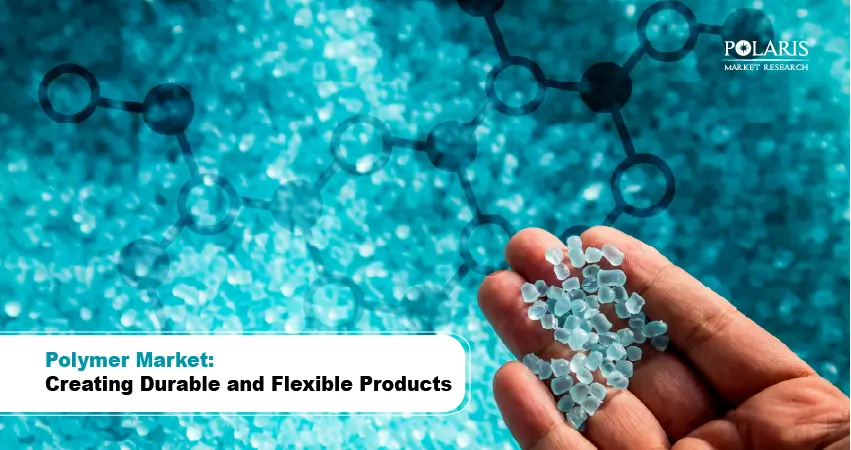Polymer Market: Creating Durable and Flexible Products

Polymers are all around us. Be it the plastic water bottle, sneakers, jackets, or phone’s earbuds. Polymers are also present in the tires of vehicles. Interestingly, several proteins in the body are polymers as well. Consider keratin, from which hairs and nails are made. Even the DNA in cells is a polymer.
Curious to know what makes polymers so special? In this blog post, we explain to you the essentials of polymers. We cover the key stats and factors driving the demand for polymers across the globe. Keep reading!
What Is a Polymer?
A polymer is a chemical substance. It is made from repeating monomer units that are linked into long networks or chains. Polymer occurs naturally. Take, for example, DNA, which is formed from four nucleic acids. Polymers can also be manufactured, as with plastics such as nylon. The structure of the polymer, such as flexibility and solubility, determines the hardness, flexibility, and other properties of the polymer. Several everyday materials rely on polymers to achieve improved performance.
What Are Key Market Metrics?
The polymer market is expected to witness sustained growth, according to the latest assessment by Polaris Market Research. The market for polymers stood at USD 784.44 billion in 2024. It is projected to account for a CAGR of 5.32% between 2025 and 2034.
What’s the Chemistry of Polymers?
Polymers are organic chemicals that have a repeating structure. The presence of a repeating structure can make polymers sound simple. But, in reality, they can get highly complex. The monomers in polymers can be two, three, or more.
The physical and chemical properties of polymers can be very different. The properties are based on the monomer type being used. The placement of weak and strong bonds across the polymer structure also determines the properties. Polymers can form single chains or have forked branches. Then there may be a network of intertwined monomers. Interestingly, polymers based on the same monomer can have different properties depending on how their polymerization is done.
What Are Common Types of Polymer Products?
Thermoplastics
A thermoplastic is a polymer class that softens upon the application of heat. Heating and cooling thermoplastics doesn’t change even if they are heated and cooled several times. This makes thermoplastics easily recyclable. Thermoplastics are obtained through a polymerization process that joins monomers to form long chains. Thousands of monomers may be used to create a single polymer chain. Thermoplastics are known to have a wide range of mechanical properties. Also, thermoplastics have good chemical resistance and are lighter than metals. Commonly used thermoplastics include polypropylene and polyethylene types from the polyethylene market.
Thermosetting Polymers
Thermosetting polymers are often referred to as thermosets. These polymers are formed through the curing process, which involves the permanent hardening of a liquid or soft solid resin. The curing process is initiated by radiation, heat, or high pressure. The initial material for thermosetting polymers is typically liquid or malleable. Also, the material is designed to mould into specific shapes. After curing, the remelting or reshaping of the thermoset isn’t possible. The covalent bonds formed during cross-linking make the thermoset resistant to heat and chemical degradation. There are various curing mechanisms available for creating different types of thermosets.
Elastomers
Elastomers are polymers with elasticity and viscosity. There are weak intermolecular forces that hold the elastomer molecules together. Elastomers have high failure strain and high yield strength. Elastomers can regain their original size and shape even after experiencing significant stretching. Natural rubber, polyurethanes, and silicone are some commonly used elastomers. The specific working temperature of these polymers varies based on factors such as seal design and media compatibility. The elastic and flexible nature of elastomers makes them essential in day-to-day life.
What Processes Are Used to Obtain Polymer Products?
Injection Molding
Injection molding is a versatile manufacturing process. It is used for producing plastic parts in large volumes. The plastic components in the injection molded plastic market are highly consistent and precise. The process begins with the injection of molten plastic material into a mold cavity. After this, cooling and solidification of the material take place. The final step involves the ejection of the finished part from the mold. There are several plastic injection molding processes available. The selection of a specific process depends on the exact requirements of the part. It is also based on factors such as material properties, part design, and production volume.
Extrusion
The extrusion process in the polymer market involves pushing the material through a die. Extrusion is a high-volume production process in which polymer material is continuously melted and formed. Gravity is used for feeding the raw material into the hopper here. The material then makes its way onto a rotating screw. The rotation of the screw pushes the material into a heated barrel. Here, the material gets compressed. Based on the die shape, there are various types of plastic extrusion processes available. These include tubing extrusion, blow film extrusion, and sheet film extrusion.
Where Are Polymers Used?
- Polymers find applications across several industries. These include packaging, aircraft, construction, and textiles.
- Polystyrene is a highly common plastic that has several applications in the packaging industry. It is used for making toys, bottles, containers, and disposable glasses.
- Polyvinyl chloride is used in the production of sewage pipes. It’s also used as an insulation in electric cables.
- Urea-formaldehyde resins are used to make molds, adhesives, and laminated sheets.
Conclusion
Polymers are chemical compounds in which the molecules are bonded in long and repeating chains. Naturally occurring polymers take the form of wool, DNA, and silk. Examples of synthetic polymers present around us include polyester and polyethylene. The latest developments in the polymer market are focused on reducing the environmental impact of synthetic polymers. The adoption of biodegradable polymers is expected to rise in the years to come.

